Handling Automated Jira Tickets for New EventBridge Schema Discoveries
Let me start at the beginning. In my role as an AWS Cloud Engineer at one of my previous clients, an event-driven architecture was used where third parties constantly sent many events to our AWS environment via EventBridge. For each third party, we provided an event bus with various EventBridge rules.
The challenge here was keeping track of the event structure—how it was organized. Events were frequently updated, leading to many meetings to clarify things.
At the end of 2019, a large part of our problem was solved thanks to EventBridge Schema Discovery. By enabling this on the event buses, schemas were automatically generated based on the received events. This allowed us to generate code bindings from these schemas, which was a great help in our object-oriented environment.
Below you can see a very basic example event of a third party.
{
"version": "0",
"id": "ef21d5fc-a5ba-e2c6-fc4b-a8807455c64d",
"detail-type": "orderType",
"source": "com.company.A",
"account": "xxx",
"time": "2024-08-22T08:04:26Z",
"region": "eu-west-1",
"resources": [],
"detail": {
"orderId": 123456789,
"customer": {
"customerId": "C001",
"name": "John Doe"
},
"orderDate": "2024-08-22"
}
}
AWS discovered a schema for these types of events:
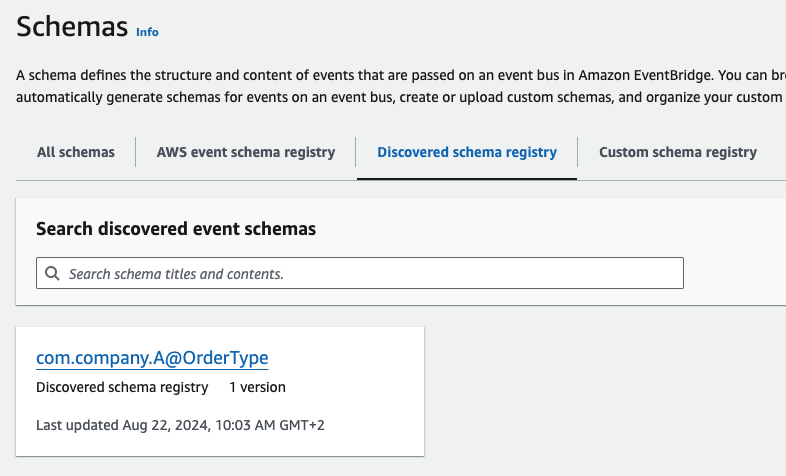
By using the AWS Toolkit for Visual Studio Code, we could easily represent our events as strongly typed objects in our code.
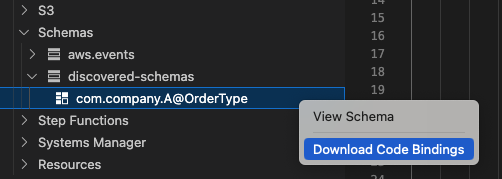
Below is a very basic example on how we used the code bindings.
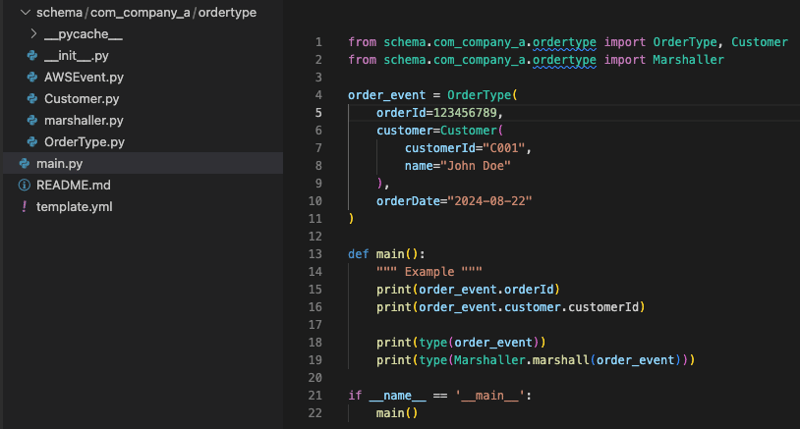
Output:
123456789 C001
This improved our way of working, but we still encountered an issue. From time to time, third parties would add new attributes to their events. EventBridge would discover these changes, but developers often forgot to update the code bindings for the new schema. Although our implementation was robust enough to prevent breakages when new attributes were added, it resulted in new data that we weren’t utilizing. We had to rely on developers to remember to update their code bindings occasionally, and there was no clear process in place to manage this.
Sometimes a code binding wasn’t updated for months, and occasionally, two developers would update it simultaneously, leading to conflicts or duplicate work.
To handle this better, we decided to build a solution that automatically creates a Jira ticket whenever a third party updates their event and a new schema is discovered.
The solution is available in CloudFormation on my GitHub. Check the README.
The first step was to create an EventBridge rule on our default bus that would trigger whenever a new schema or a schema version update was discovered. This event was then sent to an SQS queue to serve as input for an EventBridge Pipe. Here, we could add additional filtering (optional in this example) and enrich our event using a Lambda function.

For enrichment, we used the describe_schema using boto3.
data = event[0]["input"]["detail"]
try:
response = client.describe_schema(
RegistryName=data["RegistryName"],
SchemaName=data["SchemaName"],
SchemaVersion=data["Version"],
)
except ClientError as e:
raise e
return_data = {
"SchemaName": response["SchemaName"],
"SchemaVersion": response["SchemaVersion"],
"SchemaArn": response["SchemaArn"],
"Content": json.loads(response["Content"]),
}
After enriching our data, we sent it to a Step Function workflow. This workflow, in turn, triggered the AWS-provided AWS-CreateJiraIssue SSM Automation, which automatically created a Jira ticket.
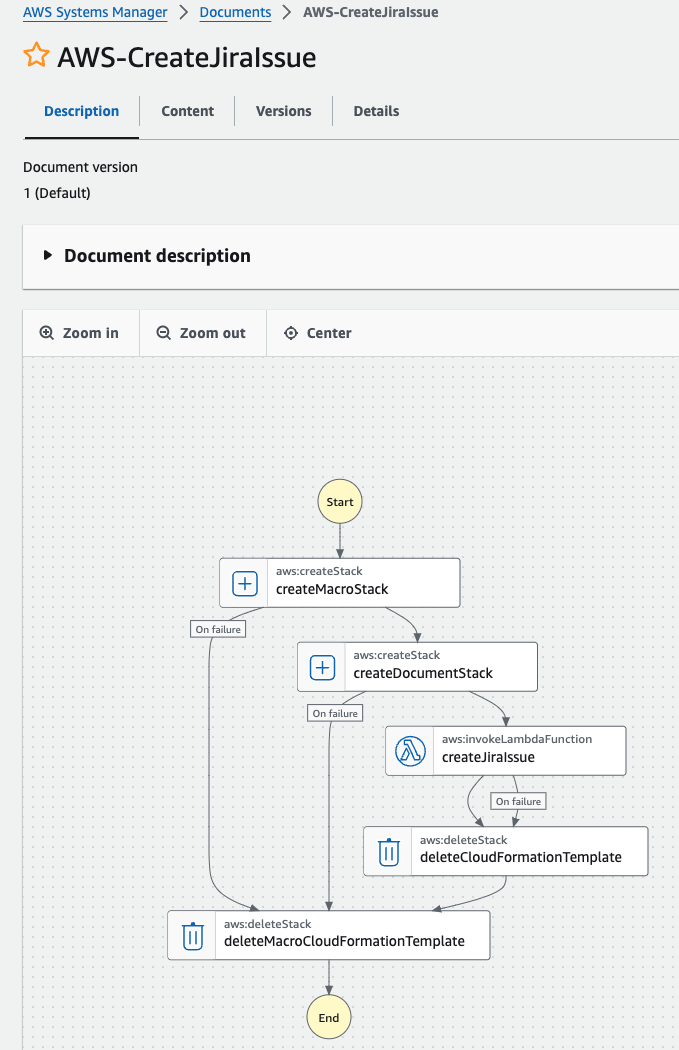
The ticket included details such as the schema name, the new schema version, and the ARN of the schema. (Additional content from the event can also be added if needed.)
---------------- -------- ------------------------- ---------------- ------------------------- | EventBridge | ---> | SQS | ---> | EventBridge Pipe | ---> | Step Function | ---> | SSM Automation Document | | Rule | | | | (Filtering & Enrichment)| | | | | ---------------- -------- ------------------------- ---------------- -------------------------
Let's demo this solution. Here you see an updated event, based on the original. The attribute status is new.
{
"version": "0",
"id": "dffbd38b-9258-d028-21f3-da0ba3c9e314",
"detail-type": "orderType",
"source": "com.company.A",
"account": "xxx",
"time": "2024-08-22T08:04:26Z",
"region": "eu-west-1",
"resources": [],
"detail": {
"orderId": 123456789,
"status": "Completed",
"customer": {
"customerId": "C001",
"name": "John Doe"
},
"orderDate": "2024-08-22"
}
}
A new schema will be discovered. This will trigger the whole solution. After the Lambda enriched our event, that updated event will be used as input for our Step Function.
The input event of our Step Function is enriched and looks like this.
[
{
"statusCode": 200,
"data": {
"SchemaName": "com.company.A@OrderType",
"SchemaVersion": "2",
"SchemaArn": "arn:aws:schemas:eu-west-1:xxx:schema/discovered-schemas/com.company.A@OrderType",
"Content": {
"openapi": "3.0.0",
"info": {
"version": "1.0.0",
"title": "OrderType"
},
"paths": {},
"components": {
"schemas": {
"AWSEvent": {
"type": "object",
"required": [
"detail-type",
"resources",
"detail",
"id",
"source",
"time",
"region",
"version",
"account"
],
"x-amazon-events-detail-type": "orderType",
"x-amazon-events-source": "com.company.A",
"properties": {
"detail": {
"$ref": "#/components/schemas/OrderType"
},
"account": {
"type": "string"
},
"detail-type": {
"type": "string"
},
"id": {
"type": "string"
},
"region": {
"type": "string"
},
"resources": {
"type": "array",
"items": {
"type": "object"
}
},
"source": {
"type": "string"
},
"time": {
"type": "string",
"format": "date-time"
},
"version": {
"type": "string"
}
}
},
"OrderType": {
"type": "object",
"required": [
"orderId",
"orderDate",
"customer",
"status"
],
"properties": {
"customer": {
"$ref": "#/components/schemas/Customer"
},
"orderDate": {
"type": "string",
"format": "date"
},
"orderId": {
"type": "number"
},
"status": {
"type": "string"
}
}
},
"Customer": {
"type": "object",
"required": [
"customerId",
"name"
],
"properties": {
"customerId": {
"type": "string"
},
"name": {
"type": "string"
}
}
}
}
}
}
}
}
]
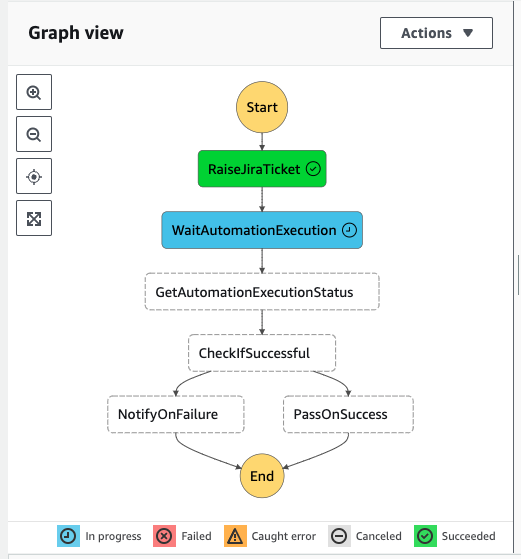
The Step Function workflow will, in turn, trigger the SSM automation and a create a Jira Ticket.
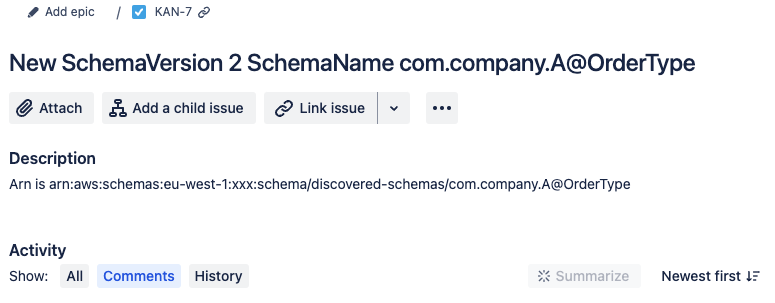
For convenience, I kept the ticket content brief. However, since the Content is also sent as input to the Step Function, it could also be included in the ticket. In that way, you can directly mention the new attributes or changes to the schema in your ticket.
This solution will also be triggered when a completely new event is discovered, as it will create a version 1 of the new event, causing the EventBridge rule to fire.
In this way, we were informed about updates and could schedule them into our sprint. This leads to an acceleration of our development cycle.
I’m aware that this is quite a specific case, but similar solutions can be built by setting up EventBridge rules to trigger on the desired events, and then using enrichment and Step Functions in combination with SSM to create further automations.
-
 How do I combine two associative arrays in PHP while preserving unique IDs and handling duplicate names?Combining Associative Arrays in PHPIn PHP, combining two associative arrays into a single array is a common task. Consider the following request:Descr...Programming Published on 2025-01-03
How do I combine two associative arrays in PHP while preserving unique IDs and handling duplicate names?Combining Associative Arrays in PHPIn PHP, combining two associative arrays into a single array is a common task. Consider the following request:Descr...Programming Published on 2025-01-03 -
 What Happened to Column Offsetting in Bootstrap 4 Beta?Bootstrap 4 Beta: The Removal and Restoration of Column OffsettingBootstrap 4, in its Beta 1 release, introduced significant changes to the way column...Programming Published on 2025-01-03
What Happened to Column Offsetting in Bootstrap 4 Beta?Bootstrap 4 Beta: The Removal and Restoration of Column OffsettingBootstrap 4, in its Beta 1 release, introduced significant changes to the way column...Programming Published on 2025-01-03 -
 Using WebSockets in Go for Real-Time CommunicationBuilding apps that require real-time updates—like chat applications, live notifications, or collaborative tools—requires a communication method faster...Programming Published on 2025-01-03
Using WebSockets in Go for Real-Time CommunicationBuilding apps that require real-time updates—like chat applications, live notifications, or collaborative tools—requires a communication method faster...Programming Published on 2025-01-03 -
 How Can I Find Users with Today\'s Birthdays Using MySQL?How to Identify Users with Today's Birthdays Using MySQLDetermining if today is a user's birthday using MySQL involves finding all rows where ...Programming Published on 2025-01-02
How Can I Find Users with Today\'s Birthdays Using MySQL?How to Identify Users with Today's Birthdays Using MySQLDetermining if today is a user's birthday using MySQL involves finding all rows where ...Programming Published on 2025-01-02 -
 How to Fix \"ImproperlyConfigured: Error loading MySQLdb module\" in Django on macOS?MySQL Improperly Configured: The Problem with Relative PathsWhen running python manage.py runserver in Django, you may encounter the following error:I...Programming Published on 2025-01-02
How to Fix \"ImproperlyConfigured: Error loading MySQLdb module\" in Django on macOS?MySQL Improperly Configured: The Problem with Relative PathsWhen running python manage.py runserver in Django, you may encounter the following error:I...Programming Published on 2025-01-02 -
 Beyond `if` Statements: Where Else Can a Type with an Explicit `bool` Conversion Be Used Without Casting?Contextual Conversion to bool Allowed Without a CastYour class defines an explicit conversion to bool, enabling you to use its instance 't' di...Programming Published on 2025-01-02
Beyond `if` Statements: Where Else Can a Type with an Explicit `bool` Conversion Be Used Without Casting?Contextual Conversion to bool Allowed Without a CastYour class defines an explicit conversion to bool, enabling you to use its instance 't' di...Programming Published on 2025-01-02 -
 How to Remove Rows with Null Values from a Pandas DataFrame Column?Dropping Null Values from a Pandas DataFrame ColumnTo remove rows from a Pandas DataFrame based on null values in a specific column, follow these step...Programming Published on 2025-01-01
How to Remove Rows with Null Values from a Pandas DataFrame Column?Dropping Null Values from a Pandas DataFrame ColumnTo remove rows from a Pandas DataFrame based on null values in a specific column, follow these step...Programming Published on 2025-01-01 -
 How Can I Correctly Type Assert a Slice of Interface Values in Go?Type Asserting a Slice of Interface ValuesIn programming, it's common to encounter situations where you need to type assert a slice of interface v...Programming Published on 2025-01-01
How Can I Correctly Type Assert a Slice of Interface Values in Go?Type Asserting a Slice of Interface ValuesIn programming, it's common to encounter situations where you need to type assert a slice of interface v...Programming Published on 2025-01-01 -
 Why Does `list.sort()` Return `None` and How Do I Get the Sorted List?Understanding the Sort() Method and Its Return ValueWhile attempting to sort and return a list of unique words, you may encounter a common issue: the ...Programming Published on 2025-01-01
Why Does `list.sort()` Return `None` and How Do I Get the Sorted List?Understanding the Sort() Method and Its Return ValueWhile attempting to sort and return a list of unique words, you may encounter a common issue: the ...Programming Published on 2025-01-01 -
 How Do I Make a `preg_match` Regular Expression Case-Insensitive?Making preg_match Case InsensitiveIn the code snippet provided in the question, case sensitivity is preventing the intended result from being achieved...Programming Published on 2025-01-01
How Do I Make a `preg_match` Regular Expression Case-Insensitive?Making preg_match Case InsensitiveIn the code snippet provided in the question, case sensitivity is preventing the intended result from being achieved...Programming Published on 2025-01-01 -
 How Can a DocumentFilter Effectively Restrict JTextField Input to Integers?Filtering JTextField Input to Integers: An Effective Approach with DocumentFilterWhile intuitive, using a key listener to validate numeric input in a ...Programming Published on 2025-01-01
How Can a DocumentFilter Effectively Restrict JTextField Input to Integers?Filtering JTextField Input to Integers: An Effective Approach with DocumentFilterWhile intuitive, using a key listener to validate numeric input in a ...Programming Published on 2025-01-01 -
 How to Set `ulimit -n` from a Go Program?How to set ulimit -n from a golang program?Go's syscall.Setrlimit function enables setting ulimit -n from within a Go program. This allows for cus...Programming Published on 2024-12-31
How to Set `ulimit -n` from a Go Program?How to set ulimit -n from a golang program?Go's syscall.Setrlimit function enables setting ulimit -n from within a Go program. This allows for cus...Programming Published on 2024-12-31 -
 Why Does Java Print Arrays Strangely, and How Can I Print Their Contents Correctly?Weird Array Printing in JavaIn Java, arrays are more than just a collection of values. They are objects with a specific behavior and representation. W...Programming Published on 2024-12-31
Why Does Java Print Arrays Strangely, and How Can I Print Their Contents Correctly?Weird Array Printing in JavaIn Java, arrays are more than just a collection of values. They are objects with a specific behavior and representation. W...Programming Published on 2024-12-31 -
 Session Management in PHP with Lithe: From Basic Setup to Advanced UsageWhen we talk about web applications, one of the first needs is to maintain user information while they navigate through the pages. That’s where sessio...Programming Published on 2024-12-31
Session Management in PHP with Lithe: From Basic Setup to Advanced UsageWhen we talk about web applications, one of the first needs is to maintain user information while they navigate through the pages. That’s where sessio...Programming Published on 2024-12-31 -
 How Can I Optimally Construct SQL Strings in Java for Database Manipulation?Optimal Methods for SQL String Construction in JavaManipulating databases (updates, deletes, inserts, selects) often involves building SQL strings. St...Programming Published on 2024-12-31
How Can I Optimally Construct SQL Strings in Java for Database Manipulation?Optimal Methods for SQL String Construction in JavaManipulating databases (updates, deletes, inserts, selects) often involves building SQL strings. St...Programming Published on 2024-12-31
Study Chinese
- 1 How do you say "walk" in Chinese? 走路 Chinese pronunciation, 走路 Chinese learning
- 2 How do you say "take a plane" in Chinese? 坐飞机 Chinese pronunciation, 坐飞机 Chinese learning
- 3 How do you say "take a train" in Chinese? 坐火车 Chinese pronunciation, 坐火车 Chinese learning
- 4 How do you say "take a bus" in Chinese? 坐车 Chinese pronunciation, 坐车 Chinese learning
- 5 How to say drive in Chinese? 开车 Chinese pronunciation, 开车 Chinese learning
- 6 How do you say swimming in Chinese? 游泳 Chinese pronunciation, 游泳 Chinese learning
- 7 How do you say ride a bicycle in Chinese? 骑自行车 Chinese pronunciation, 骑自行车 Chinese learning
- 8 How do you say hello in Chinese? 你好Chinese pronunciation, 你好Chinese learning
- 9 How do you say thank you in Chinese? 谢谢Chinese pronunciation, 谢谢Chinese learning
- 10 How to say goodbye in Chinese? 再见Chinese pronunciation, 再见Chinese learning

























